By: Richard W. Sharp
A side-effect of Donald Trump’s twitter habit is that he reveals his sources of information, and these can help us measure the gap between his perception and the reality in which we live. It’s no secret that Trump lives in a bubble, or that his biased views contribute to his poor decision-making. In last week’s Politics chat, we suggested that a long-term cure for demagoguery is better primary and secondary education, specifically teaching critical thinking skills, because it is the process of discovering, measuring, and correcting biases (our own and those of others) to arrive at more accurate, nuanced analyses and, most importantly, better decisions.
To make good decisions you must have good information.
Last Thursday, El Presidente retweeted an internet poll:
ProgressPolls was widely noted for its…um…”unique” stance in the crowded field of presidential popularity tracking.
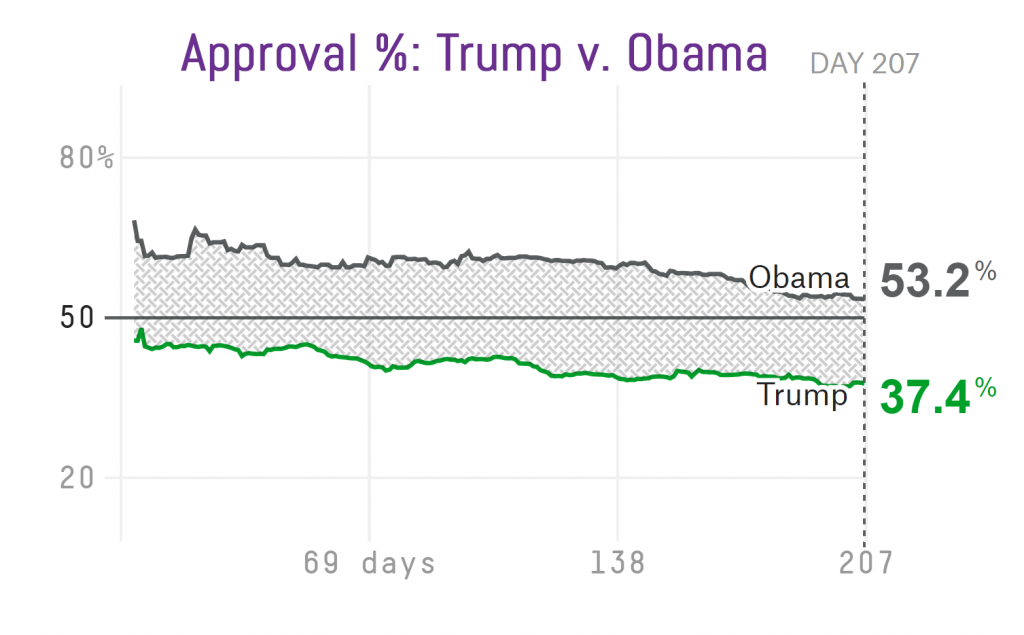
Aggregate approval ratings. Source: FiveThirtyEight.
Furthermore, among Republicans, Independents, and Democrats, Republicans are the sole group in which more than 50% approves of the President. That is, the ProgressPolls result looks a lot more like a poll of GOP voters than a poll of the American population but is presented as “representing large masses of opinion.” This disclaimer (screenshot below, as it was later taken down) pretty clearly is meant to imply that the poll is representative of an unbiased, non-cherry picked pool of respondents:
No surprise there, as ProgressPolls turns out to be a very recent Twitter entity that specializes in Twitter polls instead of scientific ones. Online polls can be fun, but have to be viewed through the filter under which they were conducted: self-selected users or followers of the particular site or account in question. The results of the poll don’t look like the national presidential approval aggregate because the followers of ProgressPolls aren’t a representative sample of Americans. Instead, with regard to this poll only, they look a lot more like a sample of the Republicans in the Gallup tracker.
Another favorite information source that frequently appears in Trump’s stream is Fox News, and especially Fox & Friends. It is widely reported that Trump watches “religiously,” as do many of of his voters. In fact, it’s gone beyond a simple source and become a platform for personalized infomercials, tailored for an audience of one. However, the information presented by Fox News has been questionable at best.
While a typical politician is careful to manage the public perception of his opinion (meat for the base and reassurance for the rest), Trump’s use of Twitter is his unique connection to the public at large. He has shown no restraint or hesitation at the keyboard and asserts it is his own unfiltered voice. We believe him. Further, we believe that he shares the opinions represented therein. We may take the bias or inconsistency we uncover in his sources as part of the bias that shapes the President’s decisions.
The question
How consistently does the worldview revealed by 3 key question posed by ProgressPolls and topics covered on Fox & Friends track verifiable facts, the opinion of the country at large, or the opinion of Trump’s base?
We examined two other ProgressPolls Twitter surveys, conducted before a single short fingered tap placed them on the national stage, to gain a rough idea of how the opinions of the ProgressPolls participants mirror the opinions of the nation:
- Trump’s approval ratings v. Obama’s (at the same point in his tenure)
- The existence of a gender wage gap.
- LGBT soldiers in the US military.
We also take a look at the president’s affiliation with Fox & Friends and the veracity of the information presented on the network.
The short-short version
Trump favors the opinions of his base: Republican men.But it gets complicated.
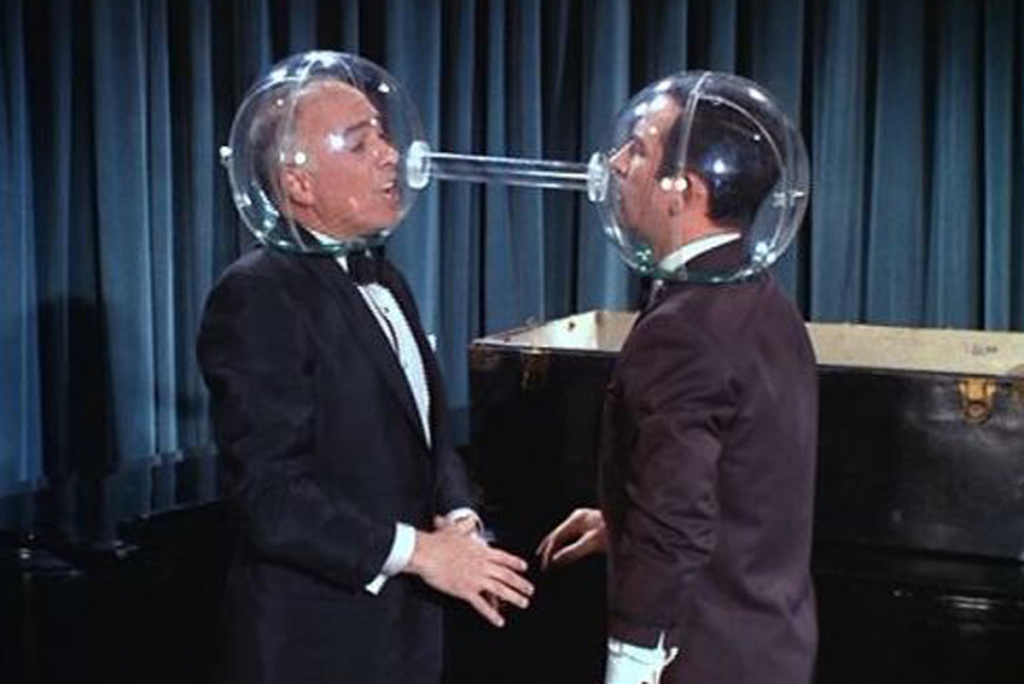
Two white guys living in a bubble. Of silence.
The results part I: ProgressPolls
We’ve already seen that Trump’s view of his job performance mirrors his base more so than the country at large, so let’s dive in and take a look at two other ProgressPolls that predate that retweet and can be compared to polling or factual data from other organizations. Open polls after that date are potentially subject to hijacking by both mobilized supporters and #theresistance. Infamy brings (even more) sketchily non-representative respondent pools.
Let’s start with this July 26 ProgressPolls poll on the wage gap.
This poll is significant because the underlying issue can be measured using data that does not come from an opinion poll. The Bureau of Labor Statistics,1 for example, uses actual salary data to arrive at the conclusion that “Women’s median earnings [were] 82 percent of men’s in 2016.” While arguments rage over the proper way to measure and explain the effect, the general conclusion of many studies is that the effect is real.
So the ProgressPolls result is clearly not in step with direct measurement, but what about perception of the issue? It is difficult to make a direct comparison because, while polling on the issue has been done by others, few ask the question in the same or similar way. A Huffington Post/Yougov poll found that only about one in three respondents felt that new laws are needed to “ensure men and women are treated equally in workplaces,” while about the same amount felt that no change was necessary.
However, a Pew Research Center poll did ask if women earn less than men for the same work. Overall, 55% agreed that men earn more, reflecting the finding of the objective (vs. opinion) measurements. On the other hand, there is a stark split along gender lines, where only 47% of men but 62% of women hold this view. The data was not broken down by party affiliation. In the end, both the ProgressPolls result and the men only result of the Pew poll share a majority view that women do not earn less than men for the same work (though the ProgressPolls result is far stronger).
The ProgressPolls result is not aligned with direct measurement, and is best aligned with a male only skew when compared to a scientific poll.
Let’s take a glance at the scoreboard:
| Closest approximation to Trump’s view (via ProgressPolls) | |||
|---|---|---|---|
| Subject | Republicans | Men | Objective Fact / Mass Opinion |
| Presidential popularity | 1 | 0 | 0 |
| Pay Gap | 0 | 1 | 0 |
| Totals | 1 | 1 | 0 |
Yup, that’s 2-0 for Team Truthiness.
So here’s where it gets complicated. On July 26th, ProgressPolls followed Trump’s announcement (via Twitter, what else?) banning transgender people from serving in the military.
While no other polls asked this exact question, scientific polls from Rasmussen, Reuters, and Quinnipiac all touched on the issue. In a poll of 1,000 likely voters, Rasmussen asked if individuals agreed or disagreed with the president’s statement banning transgender participation due to “tremendous medical costs and disruption.” The top line finding was that 44% agree, 45% disagree, and 11% were undecided. Splitting by party lines, 64% of Republicans agreed, while only 58% of Democrats and 50% of unaffiliated voters disagree.
The Rasmussen poll also finds that “Blacks agree much more strongly with Trump’s statement than whites and other minority voters do.” Wait, so following the argument so far, are we going to argue that the ProgressPolls participants are more like the Rasmussen sample of black likely voters than the national average? No. This is why we are investigating several of the propositions put forth by ProgressPolls. Let’s back up for a minute and try that comparison again with the original question: presidential approval. How do blacks and other minorities feel about the President’s performance in general? Not so hot: 19%/69% approve/disapprove among non-white or Hispanic Americans in a March.2 So while the comparison holds for one question, it does not stand up across many.
A June poll of likely voters by Rasmussen asking whether the military’s decision to allow transgender people is good for the military found that 23% agree, 38% said it had no impact, and 31% believe it’s bad for the military. That is, only a minority think it will have a negative impact.
This result (61% of voters in the Rasmussen poll did not think transgender service would have negative imapct) was closely mirrored by a Reuters poll just after the president’s announcement that found that 58% of adults agree that “Transgender people should be allowed to serve in the military.”
Finally, a Quinnipiac poll found that American voters felt strongly (68% to 27%) that transgender individuals should be allowed to serve, but that Republicans oppose this view 60% to 32%.
Circling back to the ProgressPolls result, 57% disagree with the President’s stance on transgender service, we find that it is largely consistent with national polling. Wait, what? What happened here. Isn’t the ProgressPolls twitter poll base supposed to skew Republican, male, etc.? Well, apparently the answer is “sometimes,” and since we set out to determine the consistency of Trump’s sources of information, we’ll rate this one: inconsistent.3 The bottom line is that this poll, on launch day for the account, tracks national opinion, whereas the approval poll that landed in the President’s feed a few weeks later appears to have skewed Republican.
The results part II: Fox & Fox & Friends
The president, especially of late, is a big retweeter of Fox & Friends. Since November, he has brought attention to them more than any other organization (three times as much as any other if you don’t count the rest of Fox News).
| Retweets and @mentions by publication (12/23/16 through 8/15/17) | |||
|---|---|---|---|
| News organization | Retweets & @mentions | ||
| Fox & Friends | 70 | ||
| Fox (including Hannity) | 53 | ||
| New York Times | 23 | ||
| CNN | 23 | ||
| NBC | 23 | ||
| ABC | 15 | ||
| Washington Post | 10 | ||
| CBS | 5 | ||
However, Fox News has made a habit of promoting false narratives that support Trump. One good example came just after the first debate of last year’s campaign…
“I have it in front of me. Time magazine, Drudge Report, CNBC, The Hill, CBS — the only one that has Hillary winning is CNN, and they are the ‘Clinton News Network.'”‘
Sean Hannity, to millions of viewers.
Pertinent details:
- CBS did not conduct a poll.
- Only the CNN poll was scientific.
- The other polls were internet based, like ProgressPolls.
Such a great honor. Final debate polls are in - and the MOVEMENT wins!#AmericaFirst #MAGA #ImWithYouhttps://t.co/3KWOl2ibaW pic.twitter.com/sfCEE3I5pF
— Donald J. Trump (@realDonaldTrump) September 27, 2016
While Fox News in general has long been friendly territory for Trump, Fox & Friends holds a special place. He is a consistent watcher and frequent retweeter (7 times so far since he shared the ProgressPolls popularity result, and quite likely that number will have gone up by the time you read this).4 And it’s easy to see why its so popular with a president who constantly seeks the affirmation of the mob. The Fox & Friends “infotainment format [stands] apart [due to] its deliberate boosterism.”
At the outset, we posited that education is what’s needed to cure the biases ingrained by misleading sources of information. According to Professor Dannagal Young, the problem is deeper than simple misinformation. The strength of the Fox & Friends message, he contends, lies in the presentation rather than the content.
“Positivity, it turns out, is a key source of power for ‘Fox & Friends.’ According to Young, the University of Delaware professor, the show is a perfect illustration of the ‘elaboration likelihood model’ of persuasion. Developed in the 1980s by a psychologist and neuroscientist, the model describes two ways listeners are persuaded by an argument. The first involves thoughtful processing, in which a motivated listener engages with and challenges a message before reaching a conclusion. In the second path, persuasion stems from cues that have little to do with the logic of the argument itself—for example, the quality of the production or the presenter’s tone and attractiveness. Distracted by these secondary factors, the listener becomes more passive and less skeptical.”
An effective education strategy must do more than present reliable information, it must produce critical thinkers.
What’s next?
Of course, this kind of analysis is a double edged sword. There are also gaps in perception on the left. Uncovering and measuring these is a more significant (and actionable) task, which we will explore in a follow-up piece, in order to mount a significant resistance and to rebuild the country during the next administration.
The Opposition faces the same trap as Trump does in the MAGA bubble: if its information is wrong, then its strategy will be off. Such as, say, overestimating the level of mobilization and engagement that an anti-Trump message can bring out in, to pick a non-random example, New Jersey Congressional District 7. And nobody on the Left wants that outcome. Trust us.
Notes:
1 Prediction: the CBO better watch it’s step. The BLS, with its penchant for reporting important economic indicators based on long established methods, is just one bad jobs report away from becoming public (le etat c’est moi) enemy number 1.^
2 Ah March, when he was flying high and we were only going to bomb Iran, not North Korea a country uniquely suited to appreciate the rationality of MAD. ^
3 For the sake of speculation, here’s a practically unstable hypothesis that is consistent with the data. There were over 10,000 votes in this poll, but the next four polls had closer to 3,000. Also, many of the comments take a strong anti-trump stance (compared to a mixture of left/right in subsequent polls). Finally, this was the first ProgressPolls poll. In other words, this poll may have been widely promoted in order to build an audience, while subsequent polls relied on return visits. Was it? We’ll likely never know. Internet polls with their unpublished methodology are not to be trusted. ^
4 Who will be the first to build a model to detect which tweets are inspired by the folder of warm fuzzies? ^
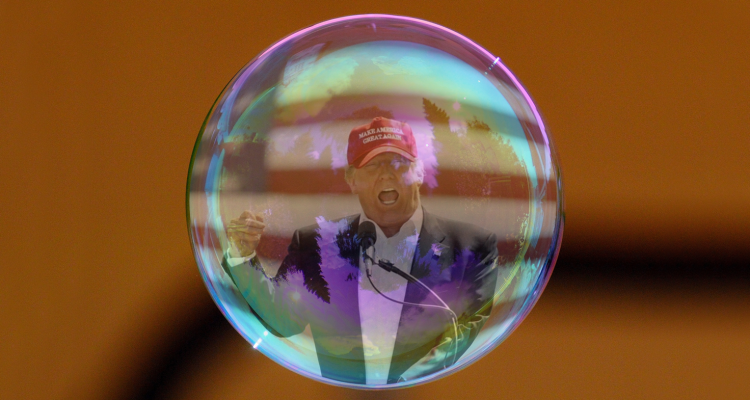
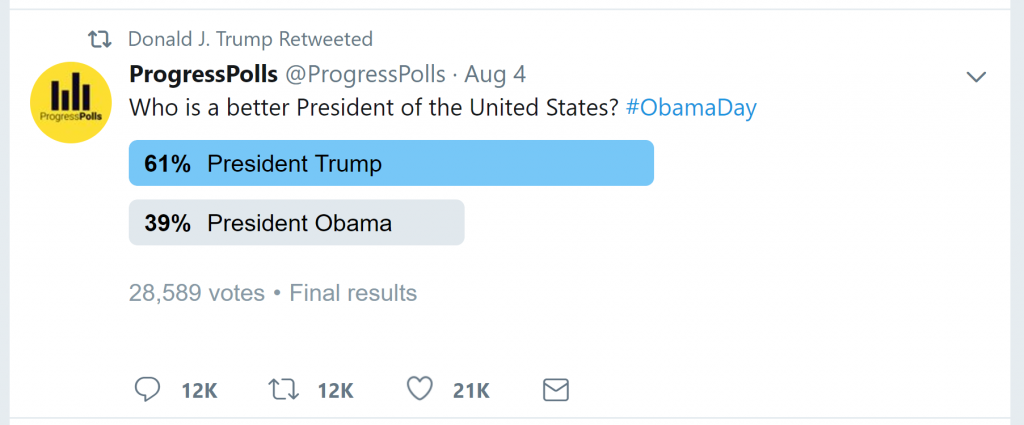

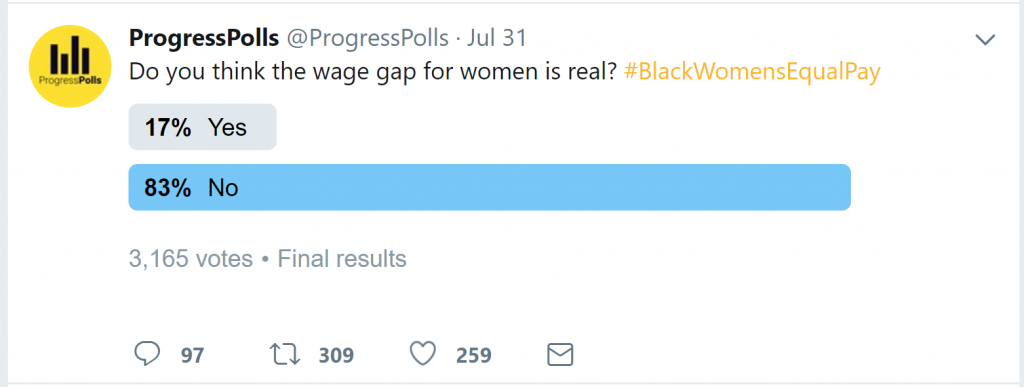
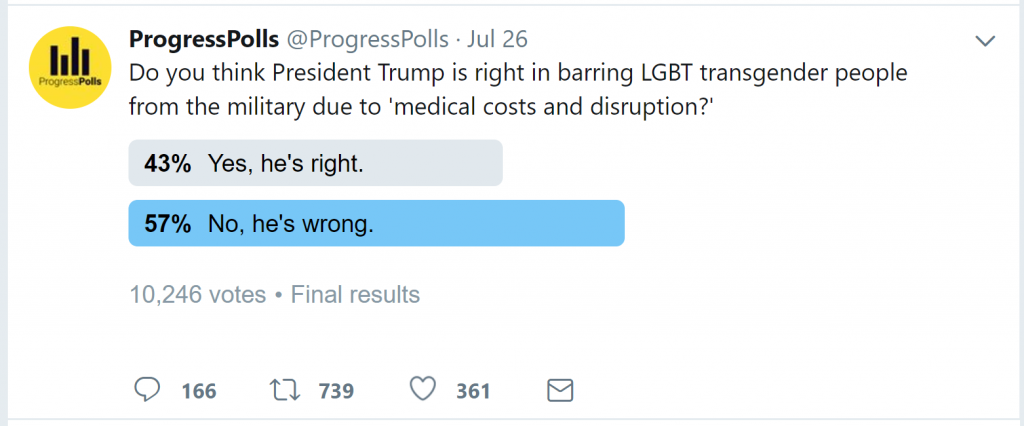
No Comments on "Inside the MAGA bubble: How bad information is affecting President Trump’s decision-making"